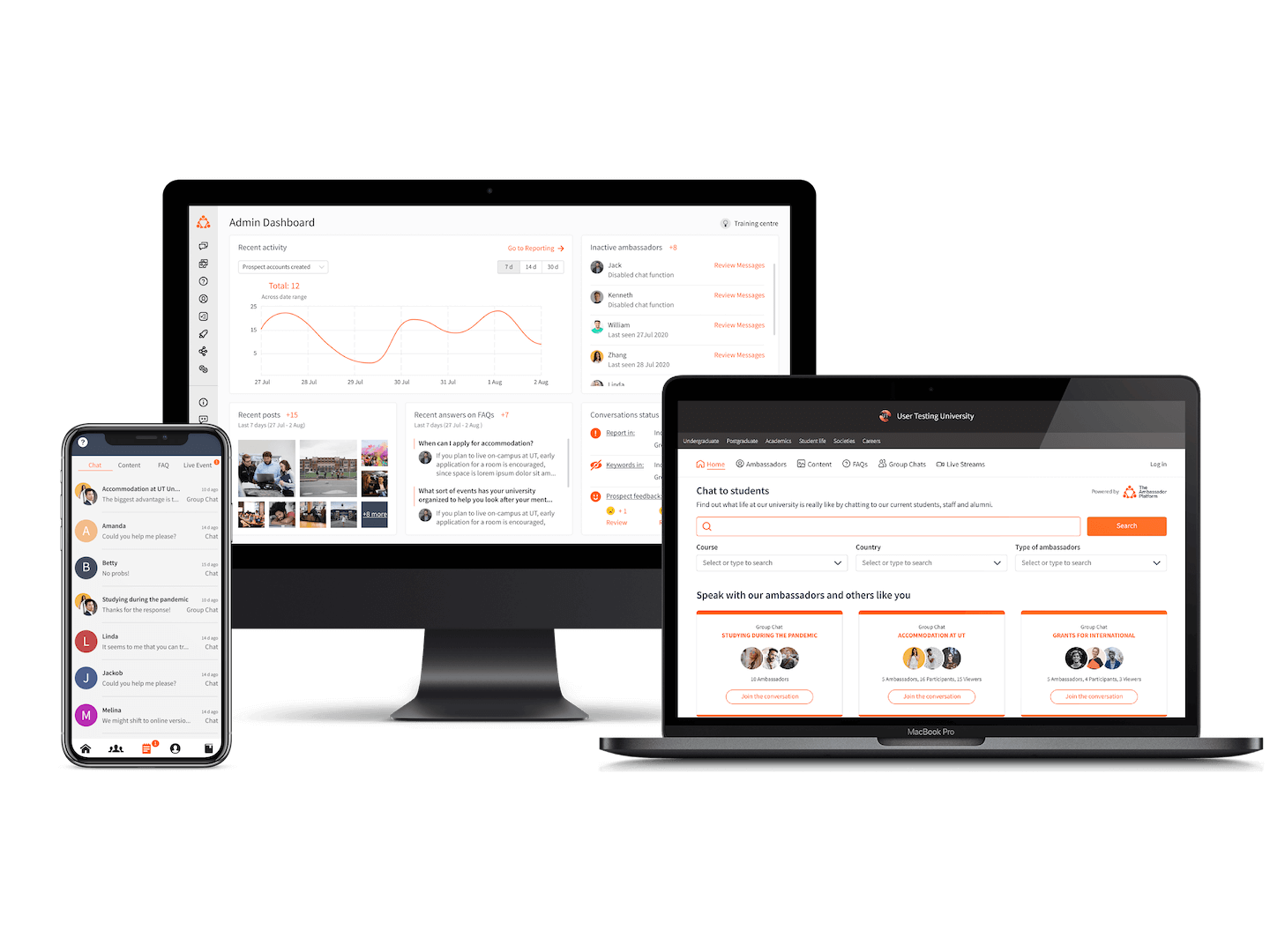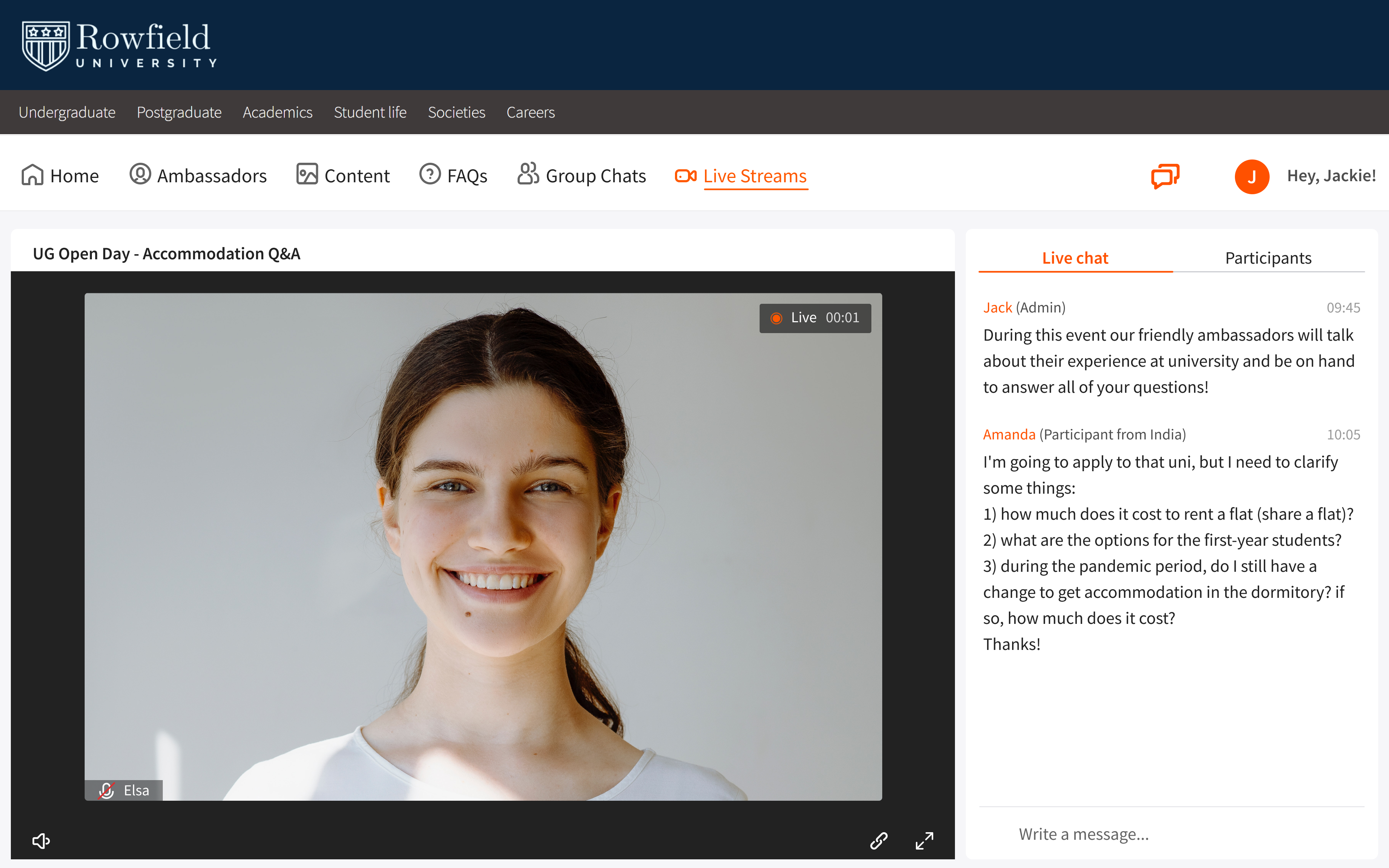Higher education marketing strategies to leverage in 2023

Gone are the days of sending out a simple brochure; now, higher education institutions have intricate, complex strategies that target key student groups, needs, and desires. The Ambassador Platform allows universities to unlock the full potential of one of the most important aspects of modern student recruitment tactics: peer-to-peer marketing.
Why Has Higher Education Marketing Changed?
Higher education marketing has undergone seismic shifts and has become almost synonymous with digital marketing. If you are interested in marketing for higher education, you will know how vital digital marketing is.
Gen Z (a term that broadly describes people born between 1996 and 2012) is the only generation that has grown up alongside social media platforms like Facebook (2004), Twitter (2006), and Instagram (2010). The rise of instant messaging platforms has unquestionably altered how people communicate, connect, and share information.
Higher education institutions are not the only organisations that are rushing to react to a sharp shift in demand. While well-established sectors and industries struggle to engage with Gen Z on their level, eCommerce businesses, social media influencers, and even the best universities around the globe are pushing personalisation, data analytics, and peer-to-peer marketing strategies to the forefront.
As academic institutions prepare for a new wave of admissions, they need to ask themselves whether they will hold onto old, ineffective strategies or fully embrace new higher education marketing strategies. If you want to discover newer, more efficient ways to capture leads and enrol students, keep reading.
Problems That Higher Education Institutions Face
Imagine this: there are 50,000 potential students in your target audience, and you have to design marketing strategies that capture their attention, answer every possible question, and ultimately encourage them to enrol at your university. It is no wonder that so many higher education marketing teams struggle to cover every base.
We have highlighted the key problems higher-ed marketing teams face, as well as possible solutions.
Going Digital
Going digital is the best thing that higher education marketers can do.
Benefits of Going Digital
Prospective students are accustomed to online communication. If your student enrolment strategy is not 80% online, you are doing it wrong.
Students Can Access Instant Information
Instant access to information is not just a positive, it is a necessity. One study found that modern humans have an eight-second attention span, which is one second less than a goldfish!
If potential students cannot find information about your courses online, the likelihood is that they will close their tab and search for a university that has more accessible information.
To get ahead of the crowd, you need to focus on optimising your digital offering. Physical brochures and prospectuses have their place, but no modern student wants to wait a week for them to arrive in the post.
Leverage the Popularity of Mobiles
Believe it or not, some websites are still not mobile-optimised. If your university's website is not compatible with mobiles and tablets, you are bound to lose a few first-class students. One study found that Gen Z spends 5.9 hours a day on their phones.
Some universities are leveraging the popularity of mobile phones by creating mobile-friendly college applications. As far as digital marketing strategies go, this is a sure winner.
Analyse Data
Why would any top university spend millions of pounds on marketing efforts that they cannot track and analyse? By engaging with your target audience in the digital sphere, you can collect data points, analyse them, and improve your higher education marketing plan.
You can even use the data to create personalised email marketing campaigns, social media posts, and messages that support students on their journey through the enrolment process.
Why Universities Struggle to Go Digital
Digital marketing is so ingrained in our society that we sometimes forget how difficult it is.
Old and New systems
Like any large institution, many universities have one overarching system that has been in place for years. The system might be supported by several CRM (Customer Relationship Management) and CMS (Content Management System) tools that staff members already know how to use.
University officials also struggle to decide between new systems and often feel confused by the number of marketing tools that are on offer. Even when they have decided on a system, it is difficult to implement them. Transferring data from one system to another and retraining staff are big financial and time obligations.
Cohesion Among Departments
Time and cost are not the only dilemmas facing university officials who want to invest in new systems. Before they make any purchases, they have to get approval from several different departments, trustees, and financial leads.
Contracts Around Old Marketing Strategies
Many older, more traditional marketing strategies come with added complications. Leaflets, brochures, and prospectuses might be old news, but lots of universities are locked into long-term contracts with suppliers.
Switching from printed prospectuses to digital versions is the most effective option, but it might not honor legally-binding contracts.
The Solution
The Ambassador Platform is an all-in-one solution to common digital marketing dilemmas. Higher education institutions can simply embed the iframe into their website, optimise their landing pages, and use the widgets to supercharge their digital marketing strategy.
Here is how The Ambassador Platform solves common digital marketing problems for universities.
- A seamless addition to your existing system - The Ambassador Platform is an iframe that seamlessly slots into your existing website. There is no need to transfer data or disrupt your departments with a new system.
- Mobile-optimised - As long as your website is mobile-optimised, so is The Ambassador Platform! You can reach your target audience at any time of the day. Prospective students can scroll through your landing page on their mobile phones.
- Integrated analytics tools - On the back end of your website, you can access analysis tools and insights that will shape your higher-ed marketing strategy.

With The Ambassador Platform, marketing for higher education recruitment has never been easier.
How Our Platform Improves Higher Education Marketing Strategies
Peer-to-peer marketing has become an increasingly popular higher education marketing strategy because it reflects Gen Z's focus on authenticity and personal connections.
Student ambassadors play a big part in The Ambassador Platform, but the iframe also comes with lots of front and back-end features that support busy marketing teams.
Video Marketing
The Ambassador Platform allows universities to capitalise on the success of video marketing. One study found that YouTube is the most used platform for Gen Z, meaning that video content is a valuable marketing tactic. Short-form videos are the future, so you need to be aware of them when you are creating a higher-ed marketing strategy.
Student ambassadors can create a range of user-generated content and upload it to our platform. Universities can also purchase a number of power-ups that hone in on video content.
- Live Streams - Student ambassadors can host real-time live streams from The Feed. Q&A sessions, careers talks, and subject-specific streams are all possible! A live group chat box stays open alongside the event, and The Ambassador Platform automatically sends out invitations and event reminders to boost engagement.
- On-Demand Streams - Universities can create a library full of useful video content for students who want to watch virtual campus tours, webinars, and degree-specific lectures. A group chat runs alongside the recording, even after the video has finished! Your marketing team can promote videos to individual prospects, which helps to personalise your higher education marketing strategy.

Of course, once you have created valuable video content you can promote it across multiple channels.
The streaming software is all part of The Ambassador Platform; institutions do not have to install new conferencing software.
Social Media Marketing
Almost 90% of Gen Z adults spend more than an hour on social media each day, and nearly half spend more than three hours on social platforms. Social media marketing should be at the forefront of your strategies, especially if you want to improve lead generation.
The Ambassador Platform has an RSS integration tool that allows marketing teams to easily share posts to social media management tools like Later.com and Hootsuite. Once an ambassador has created content (whether it is video content, written content, or otherwise) you can use the RSS tool to share it to Twitter, Facebook, LinkedIn, Instagram, and any other platform.
By developing a cross-platform strategy, you can create a consistent brand focus and attract prospective students.
The Feed
The Feed is one of the most popular parts of The Ambassador Platform. True to its name, it acts as a social media feed and shows prospective students a wide range of content.
Institutions can ask student ambassadors, successful alumni, parents, and even faculty members to create personalised profile cards for The Feed. New students read the cards and instantly know which ambassador is a good match for them. From there, they can chat with an ambassador directly or click through links to read their blogs and watch their vlogs.
.png)
Bucks New University's website attracts one million hits per year, but the marketing team still wanted to improve their marketing efforts. They employed student ambassadors and asked them to create profiles, which they uploaded to The Feed. The team also embedded profile carousels on the home page of the website for maximum visibility.
The Feed was a success! Prospective students from more than 70 countries clicked on the profile cards and began talking to student ambassadors. Even more astounding, 24% of students that used The Ambassador Platform to speak to their peers applied to Bucks New University. This shows that if marketing teams invest in student ambassadors, they will attract the attention of prospective students.
Reporting and Management Tool
The Ambassador Platform is not just a customer-facing iframe, it also has a few nifty back-end tools that can help universities optimise their websites and hone in on interested prospects.
The Reporting and Management Tool allows you to:
- Identify how prospects move through your website with the Heat Scoring tool
- Learn more about individual students with the Prospect Report feature
- Oversee the performance of your ambassador team with the Ambassador Report function
- Review how successful your campaigns and content have been with the Reporting Suite section
By investing in The Ambassador Platform, you can discover pain points for prospective students and adjust your marketing strategy accordingly.
Easily Accessible Platform
One of the best things about The Ambassador Platform is that it is easily accessible. When students access The Feed (or any other feature), they do not have to worry about travel arrangements, finances, or even suitable clothing. This is brilliant for students from low-income backgrounds and those who do not have supportive families who can drive them to your campus.
Of course, international students benefit the most. Here are some of the issues that universities face when marketing to international students, as well as a few solutions that The Ambassador Platform offers.
- Location - Location is one of the biggest barriers for global students who want to explore your campus. With our platform, this problem disappears. International students can attend virtual campus tours and watch 'day in the life' vlogs from the comfort of their bedrooms.
- Anxiety - It is no surprise that international students experience a lot of stress when choosing a university. Higher education marketing teams can address this anxiety by connecting them with existing students from the same country or state and creating FAQs that explore the international experience.
- Personalisation - Gen Z appreciates personalised marketing materials, so much so that 44% are willing to give up their data to receive a more personalised experience. Higher education marketing teams can use the features on our platform to create tailored experiences for international students. They can send emails to students that contain links to relevant profile cards in The Feed, which is exactly what the University of Adelaide did. This tactic resulted in a 66% offer holder to acceptance rate.
- Language - Lots of higher education marketing strategies do not account for different languages, which can make international students feel excluded. The Ambassador Platform overcomes language barriers by giving prospective students the ability to speak to their peers in their mother tongue. They can do this in direct or group chats.
The Ambassador Platform does not just provide a platform for higher education institutions to capture the attention of local prospects, it also creates a welcoming space for international students.
Book a Demo
Are you interested in improving your higher education marketing strategy? A live demo could be just what you need to discover how The Ambassador Platform fits into your existing strategy.
Book a demo today to discover the best in marketing for higher education.
{{cta('cb371a04-f1ca-4d8a-81d1-678f0a1c5b4f','justifycenter')}}


